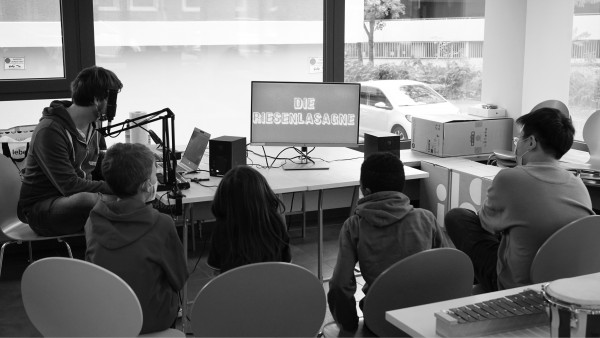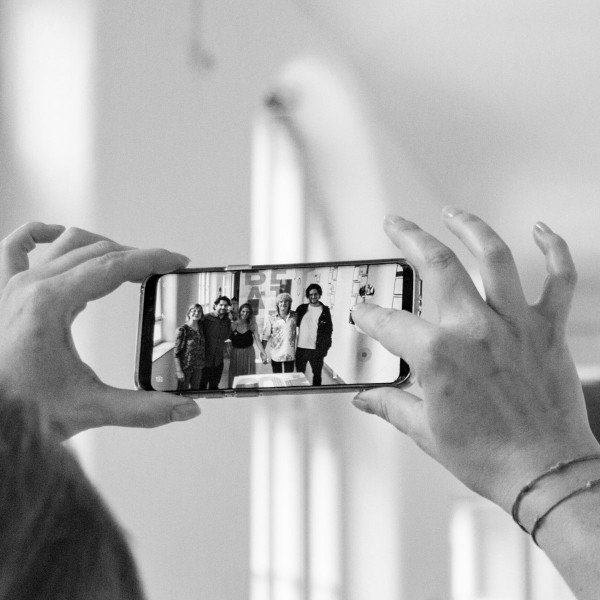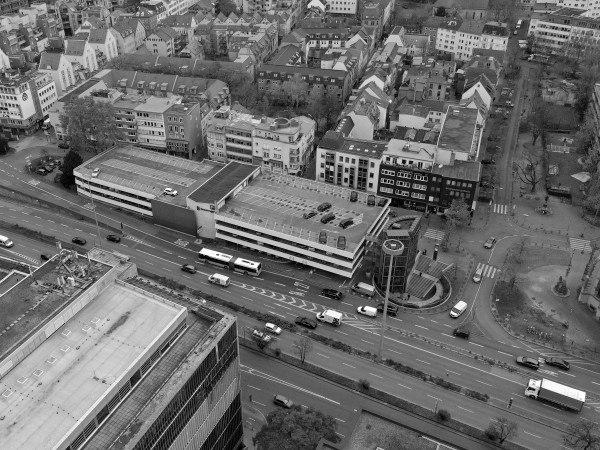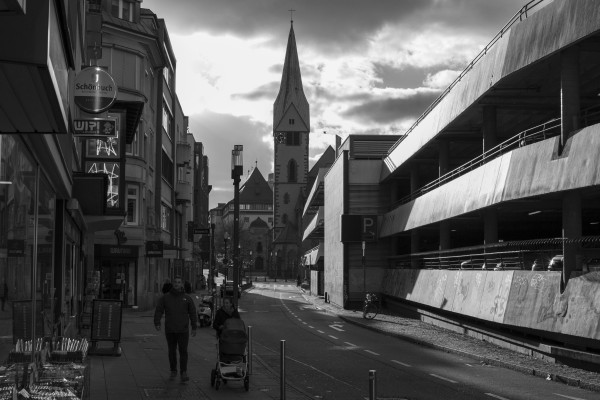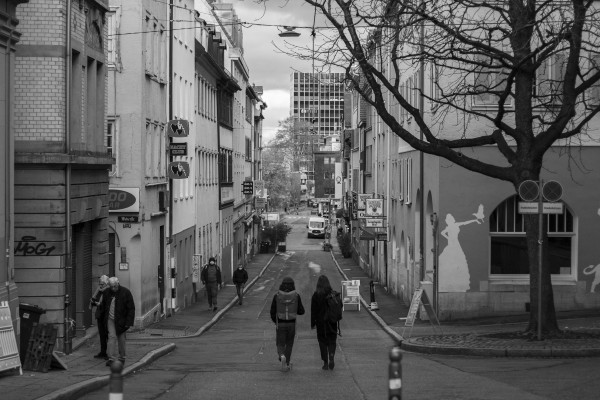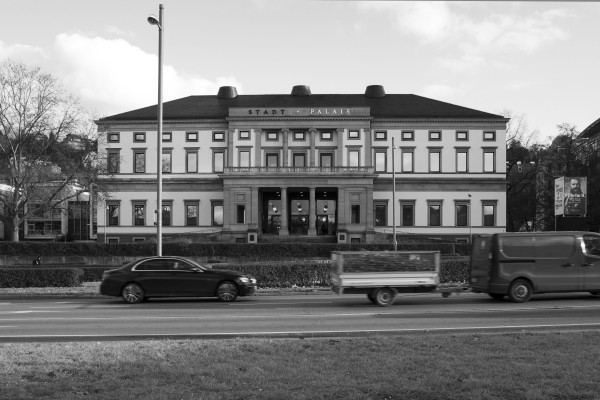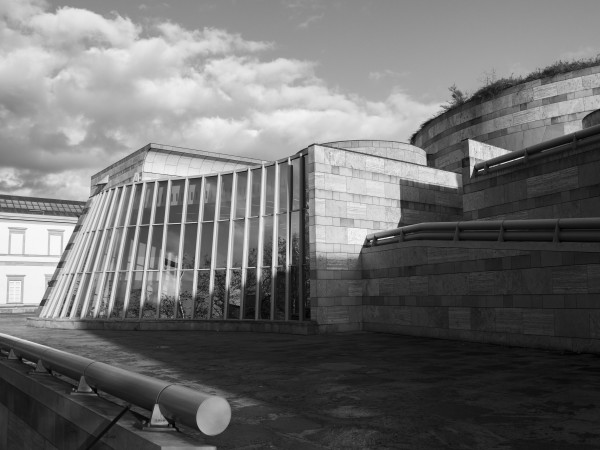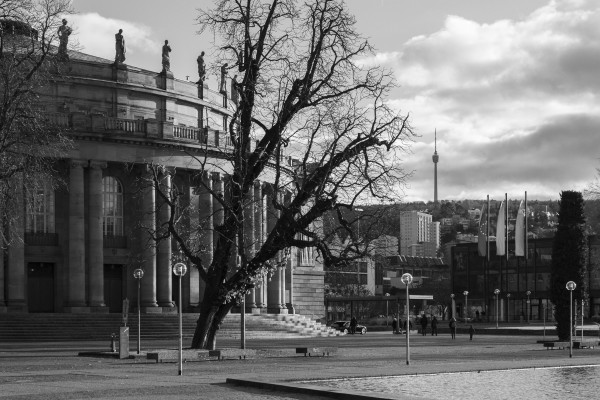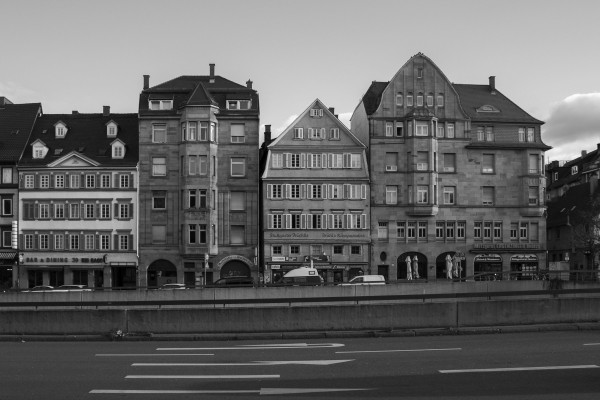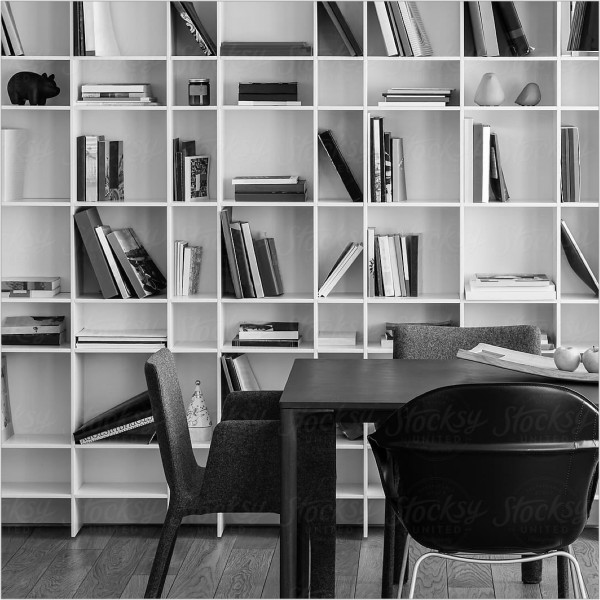Stuttgart Gets a Central Cultural Institution for the Moving Image

The Leading Medium of the Century
Film and television have changed our perception of the world in the 20th century: Our experience and behaviour are shaped by the consumption but also by our own production of audiovisual media.
Rapidly progressing digitalisation makes it possible to send large amounts of data. Thus, in the 21st century, moving images have become the medium of our time: on internet platforms, in social networks, in games, or in virtual reality applications. This makes everyone's conscious and critical approach to digital media even more important. The planned HFM enables and promotes independent and responsible media use. It thus makes an important contribution to cultural education and the promotion of film and media competence.
A Rich Cultural Offering
Stuttgart has a diverse cultural scene. What it lacks, however, is a public, central place for the interactive involvement with audiovisual, transmedial media.
Everything here is about the presentation, discussion, and creation of as well as education on analogue and digital media and media art. At the HFM, every visitor can make use of a wide variety of offers and get actively involved in all areas related to the moving image. Cooperation with Stuttgart schools will be of particular importance. On the one hand, all pupils should visit the HFM at least once during their school years. On the other hand, teachers will receive expert support in implementing the film and media-specific content of the education plan. Training opportunities in the area of film education/media pedagogy are also planned.
Timeline
-
Stuttgart's municipal cinema is one of Germany’s first and largest in terms of numbers
-
November: Initiation of the project group “Neues Kommunales Kino" (new municipal cinema) by the Film Commission Region Stuttgart, consisting of institutions in the fields of film, media, education, and culture.
Participatory process to develop a concept for a new municipal cinema in Stuttgart with 4 equal content guidelines: film and context, innovation, interculturality and education.
-
24 May: Foundation of the registered association "Neues Kommunales Kino Stuttgart e.V." by 12 institutions. The goal: to re-establish a municipal cinema in Stuttgart and to further develop it as a house for film and media.
June/July: Presentation of the possibilities of municipal film work with 5 pilot projects, panel discussion "KoKi21 – Kommunale Filmarbeit gestern und morgen" (KoKi21 – municipal film work yesterday and tomorrow) at Literaturhaus, theme evening "Über die Leinwand hinaus" (beyond the screen), children's film workshop & live TV show "Was denkst Du über das Filmemachen" (what do you think about filmmaking) with experts from the field of film & media at TREFFPUNKT Rotebühlplatz, film screening "Arabesk - Gossensound und Massenpop" ("Arabeks") followed by discussion, round table "Kunst, Kommerz, Kino - es geht um's Ganze" (art, commerce, cinema - it's do or die)
In the 1st participatory budget of the City of Stuttgart, "Kommunales Kino" achieves 9th place (1745 proposals) and 2nd place in the area of culture.
Autumn: Development of programme ideas at the "ProgrammMacherTag" (programme makers' day) with citizens and initiatives, preparation of a financing plan, development of a 3-step structure model. -
Development of first architectural designs in the term project "Film ab... - FilmKunstHaus für Stuttgart" (And… action! – FilmArtHouse for Stuttgart) (WS 2011/12) at the University of Stuttgart, Institute for Building Construction and Design.
As a working title, "Haus für Film und Medien" (House for Film and Media) now replaces "Neue Kommunales Kino" (New Municipal Cinema).
November: "Medienosten" (media east) event with more than 150 participants as possible focus space for a house for film and media.
-
April: In the 2nd participatory budget of the City of Stuttgart, "Kommunales Kino" achieves 10th place (2943 proposals) and 2nd place in the area of culture.
May: Presentation of the future concept for Villa Berg as an open house for film and media.
June: Neighbourhood dialogue "Haus für Film und Medien" in eastern Stuttgart to discuss and further develop the utilisation concept for Villa Berg.
The City of Stuttgart allocates planning funds for a three-stage planning process for the preparation of a planning study including the objectification of previous considerations and spatial concretisation in the 2014/15 biennial budget.
-
The “Filmleuchten” event is developed by the members, to take place on the 21st of December each year on the occasion of the "Kurzfilmtag" (Short Film Day).
-
1st planning phase (orientation phase) including location search by working group pesch partner architekten stadtplaner, haas cook zemmrich STUDIO2050, rmc medien + kreativ consult GmbH and COSMOTO
2nd planning phase (concept phase) including location analysis and space allocation programme/architecture, resulting in prioritisation of the Breuninger parking garage site
3rd planning phase (consolidation phase), in-depth coordination of site planning
-
3rd December: Renaming of the association to “Haus für Film und Medien Stuttgart e.V.”
-
Visits to reference institutions on film culture and education in Germany and abroad
-
14 January: Panel discussion at the "Rampe" theatre on the topic of “Kommunales Kino in Stuttgart” (municipal cinema in Stuttgart) with Andreas Vogel, Markus Merz, and Ulrich Wegenast
8 March: Open discussion at the 11th "Klappe! - JugendVideoFestival" (youth video festival) at Jugendhaus Mitte with young filmmakers on: “Was wollt ihr?” (What do you want?)
-
5 March: Basic resolution of the Stuttgart City Council on the construction and operation of a house for film and media
September: Election of the management board, appointment of project management
-
5 February: Revision of the position paper
July: Start of the first events
September: Completion of an organizational and operating concept with METRUM Managementberatung Munich as well as a hospitality concept with Ingo Wessel hospitality development
-
4 February: The design by Delugan Meissl Associated Architects (DMAA), Vienna, with Wenzel+Wenzel GmbH, Karlsruhe, is unanimously chosen as the winner of the architectural competition for the House for Film and Media.
July: Election of the management board and appointment of the first honorary member
-
Completion and opening
The HFM Includes Everyone
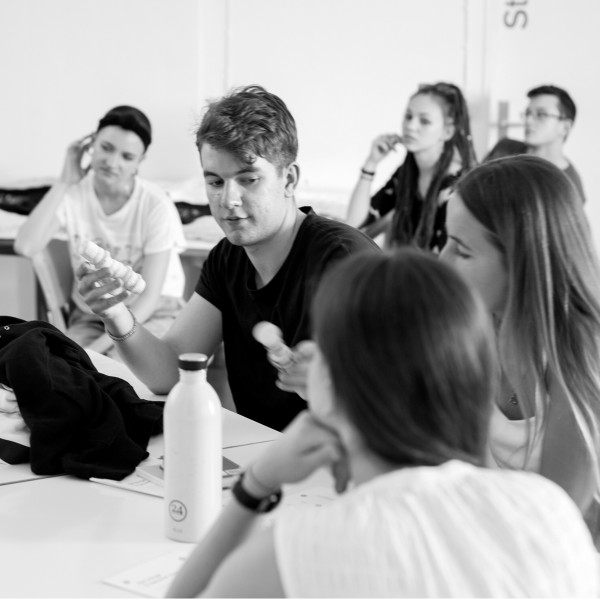
- School of seeing and understanding for all ages
- Showcase for film and media makers
- Experimental space for new media forms involving the moving image
- A setting for joint experience instead of individual consumption
- Forum for communication, exchange, and discourse
- A sign of participation and digital culture
- Stage for the lost, the unknown, the daring, the new
- Meeting place of cultures, countries, lifestyles
- Platform for film and media culture
- Visualisation of a diverse urban society
- Workshop for audiovisual production, presentation, publication
- Meeting place for diverse, invigorating togetherness
- Bridge-builder for collaborations, communities, associations, institutions
- Communication hub between education, research, and development
- Centre of competence for film and media
- A world of experiences for people of all ages
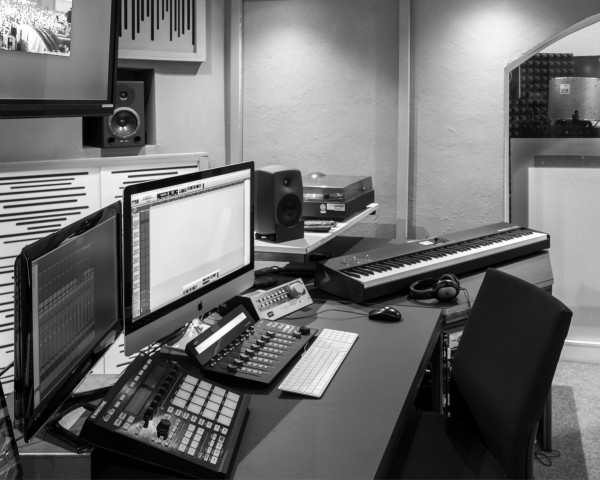
The Elements of the House
-
The HFM has one large and one small cinema auditorium. Additional screening facilities are available as required in the form of two multifunctional and two smaller screening rooms.
A special highlight is the open-air cinema on the rooftop.
We screen films and animations from the past and present, from the region and the wide world, from well-known and lesser-known countries, in the original language and beyond mainstream cinema – always embedded in a diverse programme that promotes communication between the audience and filmmakers.
-
Education on and promotion of film and media literacy through courses for all ages will be a central task of the HFM. Through workshops, active media work, and mutual exchange, children, young people, and adults learn to (better) understand films, analyse moving images, experiment with virtual and augmented reality, and be creative.
The following facilities are planned for active media work at the HFM:
- audiovisual work/research stations
- digital media archive
- makerspace
- multifunctional studio
- editing studio
- digital studio
- sound studio
- film studio
- virtual reality studio
-
On the one hand, exhibitions and events will take place in the designated areas. On the other hand, the entire building will be used as a presentation area, in whole or in part, inside and outside, depending on the occasion.
The permanent exhibition extends from the entrance area to the upper floors and forms a unity with the interior design.
Temporary exhibitions are an integral part of the annual programme and also enhance other HFM offerings: For example, they can enrich a film programme with information, present current trends in the moving image, address connections between film and other media, or show the work of film and media artists.
-
Catering areas on the ground and top floors, temporary mobile bars on each floor during events, plus vending machines for drinks and snacks.
Both locations with indoor and outdoor areas are urban meeting places with a diverse, all-day food and beverage selection. The gastronomy area on the ground floor invitingly opens up to Leonhardsplatz and contributes to the attractiveness of the neighbourhood.
In addition, there are lounge areas to linger and work with no pressure to consume.
-
The digital HFM (DHFM) is, for one, this website, which will be continuously supplemented and updated. For schools, teaching staff, and creative professionals, it will be a platform for information, research, tutorials, teaching materials, presentations, networking, cooperation, education, for the imparting and transfer of knowledge.
A "digital visit" to the HFM will also be possible: Visitors from all over the world will be able to take an intuitive and virtual stroll through the rooms and experience the diverse range of offers when visiting the website.
For another, the house itself will be digitised. Smart building elements will be applied for real-life visitors and explorers of the HFM. When entering the HFM, visitors' smartphones can connect to its interactive media guide: They will be welcomed, guided through the building, and informed about current events or exhibitions.
Urban Development
An active and attractive component of urban development: architecture and programme form a unity.
Even through the architecture and design of the building, the topics of moving image and digitality can be experienced by the visitors. This creates a unity of building and urban space, programme and education, participation and staging. The HFM wants to show that everyone is welcome here and can always experience something new.
Two new buildings are being constructed at the site of the current Breuninger parking garage on B14: the HFM facing the Leonhardskirche with a mobility hub behind it.
The HFM is located in the IBA'27 project area "Neue Leonhardsvorstadt" (the Bohnenviertel and Leonhardsviertel neighbourhoods) and with its conception already part of the IBA'27 network. The HFM thus represents an active, innovative component of urban development in the IBA'27 context.
Approaching from the city centre, the HFM together with the Leonhardskirche will form the "gateway" to the Leonhardsvorstadt. This offers an urban development opportunity to redesign the periphery of the quarter towards Hauptstätter Straße (B14) and to further develop Leonhardsvorstadt as an attractive, mixed-use, urban inner-city quarter. The new building also connects Stuttgart's cultural mile from Gebhard-Müller-Platz to Wilhelmsplatz.
Architectural Quality
The architecture, materials, and use of the HFM are characterised by innovation, sustainability, and a high degree of flexibility. The content diversity is recognisable in both the exterior and interior architecture.
Even the façade draws the attention of passers-by to the HFM's current daily programme, encouraging them to come and visit. A large, inviting entrance area with consumption-free zones, an informal atmosphere with a workshop character, and attractive catering areas convey openness and welcome visitors.
„The building is a special place because of its architecture; But it’s people who make it special by participating in it.“
The HFM sees itself as a meeting place for all citizens and for international and intercultural film and media work. It promotes individual development, allows commonalities to be discovered, builds bridges through newfound collaborations, and thus strengthens the community and cultural diversity in Stuttgart.
